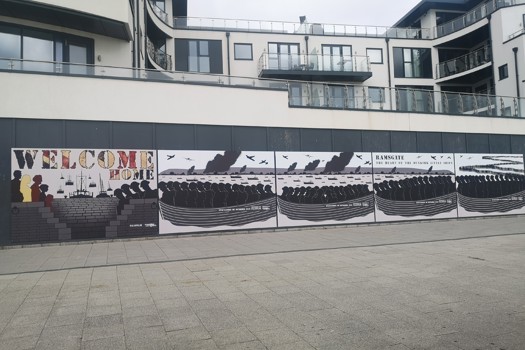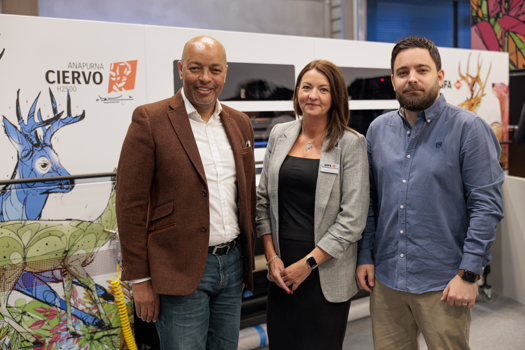How do you define ‘design'? Not easily, it turns out. American psychologist Herbert Simon came up with what is accepted
as one of the better definitions: "Everyone designs who devises courses of action aimed at changing existing situations into preferred ones." Changing existing situations into preferred ones sounds like a call to arms for every printer toughing it out in today's climate. Offering design services can help - they grow business in the corporate identity, branding and marketing arenas. While there will always be obstacles for a printer to win support as creative communications partner, some companies are scaling the barriers and using design services to win a more profitable share of customers' work.
Design is the creative fodder that fuels hungry presses; one of the obvious benefits for printers that push this added-value service is they can proactively drive more production through the press hall. "A lot of printers will design the majority of their activities toward feeding their machines," says Martin Fawcett, deputy managing director of retail marketing agency Coutts Creative Shopper, part of the Bezier Group. "What we've seen in the past is that 10% of your business is used to support the other 90%. Added-value services are there to secure your core services," adds Fawcett. Coutts also uses its design service to develop a full-service agency approach that can add up to closer client relationships and larger portion of spend.
The benefits go both ways. As the recession bites, customers have more reason than ever to outsource non-core activities - such as design - to the most cost-effective suppliers. As Williams Lea group category manager Christopher Rigg puts it: "Outsourcing is on the agenda again." But just because non-core is out, that doesn't mean design in general will be curtailed, according to recent research from the Design Council. More than half the 1,500 businesses that responded to its 2008 survey thought design would contribute to a great extent in helping maintain their competitive edge in the current economic climate.
Gap in the market
While cutbacks to UK design won't necessarily be brutal, the downturn will have an impact on the £11.6bn-turnover UK design industry. A leading London design house does not come cheap, so there's a gap in the market for the printer with the right shaped business model.
"We don't have the overheads of a design agency, because the overheads are paid for by running the presses," explains Peter Harrison, production director of The Printing House. A combined printer-designer can provide a cost-effective proposition. "In effect, all we have to cover is the cost of software, the computer and wages," adds Harrison. The Crewe-based offset and digital house follows the well-worn strategy of using underpriced design as a way to hook a customer, then making up the margins on the ensuing print. "The first job is always tough. You quite often give the design away at no charge to land a new customer," he says. It's not a charity though, but a strategy. As the firm's designers become increasingly fluent in the customer's design needs, the client relies more heavily on the supplier and foster a good relationship, allowing it to edge the price up.
Another advantage to the customer of using a printer-cum-designer is that creative work is underpinned by production, craft and cost. Every printer knows the horror story of working for a designer who can make things look pretty on screen, but can't tell their feeder from their delivery. Production people tend to throw their hands up in the air whenever these customers send in poorly outlined job specs or ask for high-quality posters from a PowerPoint document. "As a policy, we used to put everything right," says Harrison. But now he sees an opportunity. "About two years ago, we changed. We tell them we can fix it for £40 or give them advice on how to fix it."
Rather than deter clients, this more hard line stance to on-the-fly artworking actually gives The Printing House an excuse to pitch its design services. "We tell our customers you can get agency-quality design at printers' prices, and we can look after your print job while we're at it," adds Harrison. "You become a one-stop shop."
There's a definite trend for customers to look for production and design skills out-of-house, says Peter Wise, managing director of franchise Minuteman Bristol. "The idea of large marketing departments has really moved away." Wise comes from a predominantly marketing communications background, including stints at such firms as Jaguar and Nasdaq-listed furniture company Herman Miller.
Wise says that running a print shop is an extension of this. "The attraction for me in this business is it's like having a marketing department but you've got the production inside," says Wise. He has found that SME customers in particular aren't used to dealing with design houses - or paying their prices - and find a printer to be a more cost-effective option. One such client, independent vehicle finance firm Mulberry Financial Services, brought Minuteman in on the ground level to develop its corporate image. This ranged from producing printed and online marketing communications, from stationery, such as A4 letterheads, compliment slips and business cards, to designing the Mulberry company website. "How you're perceived as a business by the client is just elevated by that," adds Wise.
Full-service offering
The full-service approach is also helping The Printing House climb its way up the value ladder, says Harrison. "For some years, we've done design work for the UK arm of a multinational company. We do 100% of their design. When they did a rebrand, they actually got the chairman over from Switzerland to discuss it with me. We actually got right to the top of an international company."
However, design is not all smooth sailing. Entry-level design is becoming an increasingly commoditised skill, thanks largely to the plethora of easily accessible software or online services such as HP's MarketSplash initiative. Few know this better than Marcus Lynch, application engineer for design and desktop publishing powerhouse Adobe. "There's less need for design services these days because people are finding it easier to do it themselves," he says. "To an extent, we're facilitating that." Things like business cards are easily ordered via online templates. For example, Lynch explains that greetings card company Hallmark uses Adobe InDesign Server to power its online personalised card service. The software developer has put design into the hands of the people.
Because basic design from templates is so easily handled, printers need to offer more than just a logo or letterhead to be taken seriously. Caroline Metcalfe, client services director at HPM Group, says: "From a print perspective, there's even more need now for good conceptual thinking. A template is a template and sometimes that's enough. But to come up with concept, you need to think creatively about an idea." The County Durham-based business had sought to reposition as a marketing and branding specialist, having acknowledged that design offered a roadmap to growth. "The way the print industry was going, it seemed sensible to expand design work, not just for print, but for all marketing solutions," says Metcalfe, who joined from an advertising background that would prove invaluable to HPM. The group's remit now extends to advertising, PR, event management, web design and photography, at prices that undercut design houses.
"From a customer perspective, that's a great advantage," says Metcalfe. In any business - and especially in this economic climate - cost is king. HPM can quote below design-only companies thanks to its full-service offering. "The advantage for us is that an advertising agency will sub-contract out the print and add a mark-up," says Metcalfe, who has seen firsthand just how much agencies try to screw printers down on price. What printers don't realise, she adds, is just how much extra margin agencies then put on top.
But lower prices aren't everything. The company turned its creative searchlight inward; the most crucial branding exercise would be internal. HPM had started its life as Hillprint, but in trying to be taken seriously as a full-service agency, it dropped ‘print' off its name. HPM had operated a "jobbing design facility" for years, but like many printers had struggled with the credibility factor. Having been on the other side of the fence, Metcalfe knew this only too well.
Creative insight
Coutt's Fawcett says he has had to take a "thick-skinned approach" to this image problem for over a decade. "If you work for a printer, clients ask what possible creative insight you can bring. The perception has been that if you're known to your clients as a printer, you'll be given second shot at something creative, rather than first shot." But he concedes that opportunities from brands and retailers are improving as clients combine their print and marketing budgets. The flipside to this is that marketing companies enter the production space, generally through acquisition. "Marketers are having to move downstream and manufacturers have to move up. I think it's more difficult for agencies to move down because they have to acquire to do that. Over the last few years, the manufacturers have done this by employing skill," Fawcett adds.
The other risk is increased competition from print management (PM), which also has its sights locked on the creative design and marketing arena. Leading companies like Williams Lea and RR Donnelley Global Document Services (see box out) have pinned their single-source supplier model on end-to-end brand communication. It's generally going to be a hard sell for a printer to convince its clients, be they blue-chip or SME, that its creative services are the match of the design establishment or PM giants, so it's little wonder that HPM and Minuteman are both past winners of BPIF/Printing World Excellence Awards in Marketing. They're just two examples of UK printers that are putting a fresh spin on their creative approach to come up with a new definition of design.
CASE STUDY
RR Donnelley GDS and National Archives of Scotland
Few print organisations embody the full-service pitch as comprehensively as print managers, and few come as large and wide ranging as RR Donnelley Global Document Solutions (GDS). The division covers marketing services management, creative and presentation services, print management, office communications management, transactional printing, back office processing and content management. One of its existing clients, the National Archives of Scotland, wanted to refresh its visual identity, so GDS went head to head with creative design agencies in a three-way pitch.
While the Archives historic logo garnered some positive feedback, it was considered "too official and institutional" and, moreover, lacked the flexibility to be used in a variety of formats and didn't work on a smaller scale. Enter GDS, which took a combined production and creative mindset to the client-focused project.
"We were able to work closely with the heads of department to identify their requirements and concerns to come up with a new look that would encapsulate the importance of the Archives," says GDS creative manager Corey Stewart.
Importantly, the esteemed organisation's new brand could be repurposed across corporate literature, stationery, business cards, key rings, mugs, t-shirts, pens, marketing collateral, websites, signage and major building dressings.
The project exemplifies the kind of high-level relationships that print service providers can foster with their customers thanks to design services. It also proves that print companies can hold their own against the design community. Fred Pollock, GDS managing director (Scotland & Ireland), adds: "We won the competitive pitch against creative design agencies, which shows how far we have come in developing our services. We not only provide graphic design, but also offer a fully integrated strategic consultancy for all our clients."









